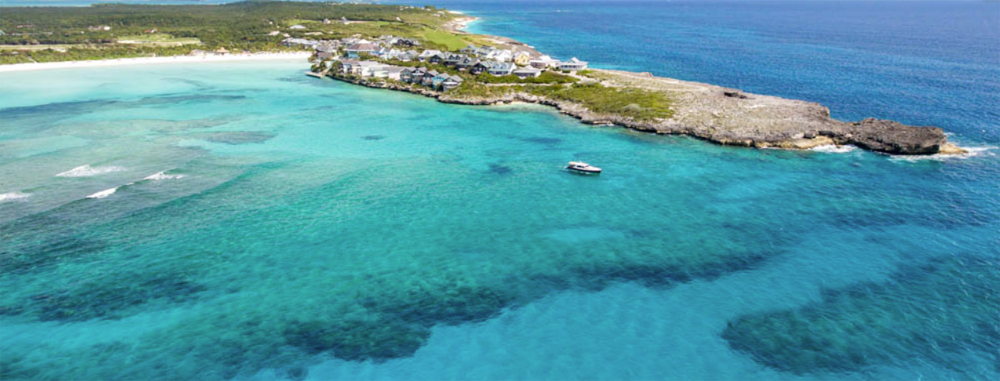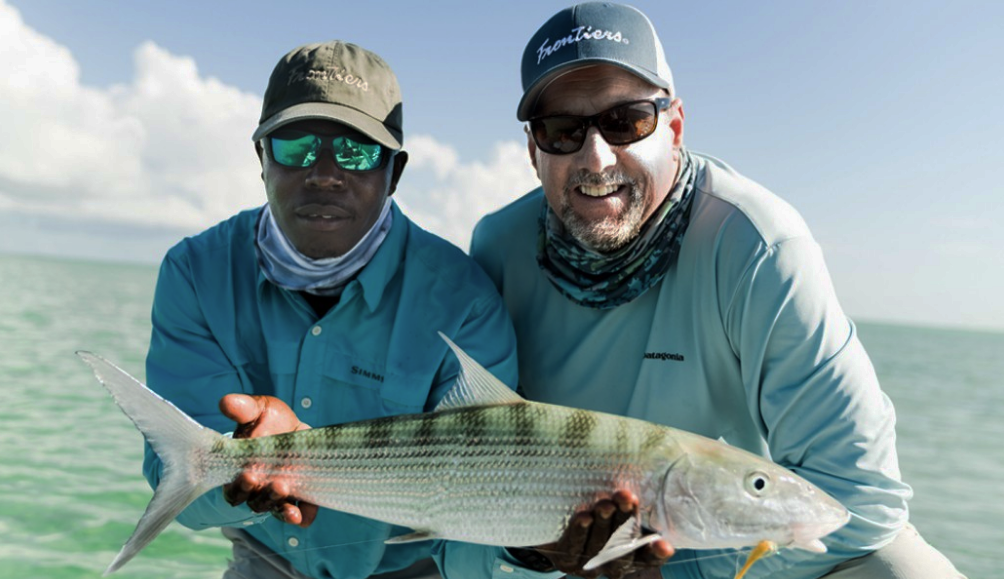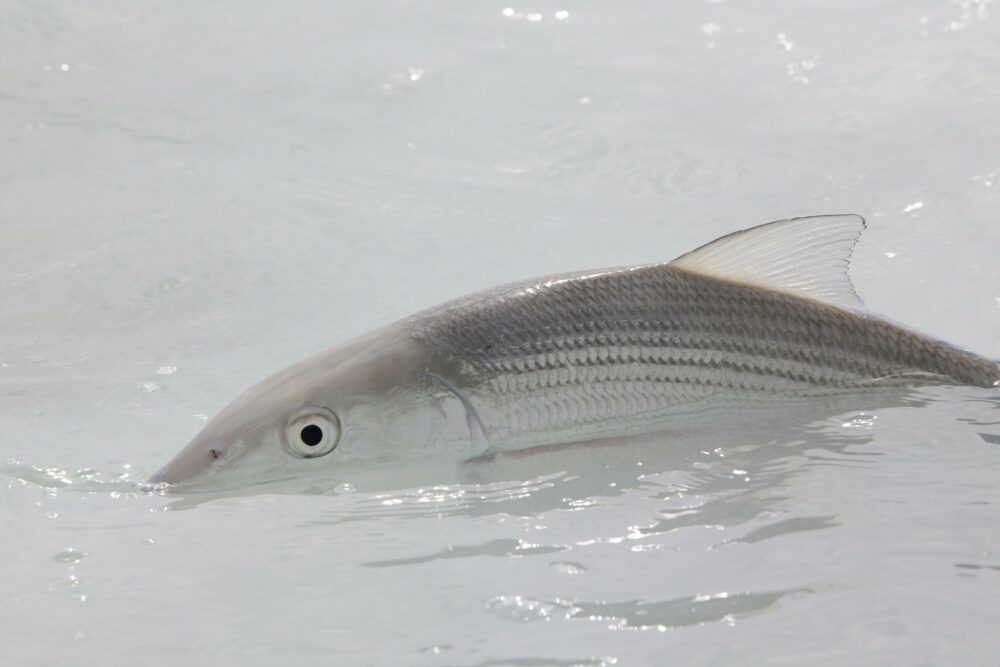
Abaco Club at Winding Bay, Abaco Island, Bahamas. Yellow Dog Flyfishing Adventures.
There are more bonefish than ever – ‘biggins’ too
By Skip Clement
It’s been a long time since I visited the Bahamas for a fly fishing trip so, it was an unexpected pleasure to be invited to do so at the end of March. Usually, that’s the end of the winter winds that frequent South Florida and make their way to the Northern Bahamas, dissipate in a day or so, and then repeat until late March and sometimes into early April.
The wind is both good and bad. Its turbulence provides cover, allowing closer shots but always interfering with the all-important presentation by creating interference in the form of resistance or anti-accuracy defense.
Rods, reels, and fly lines, and tech advances in all of them have made the game easier for the hunter, and the clothing tightened our grip on advantages as well. All the latest advances have happened over a relatively short time.
The Great White Guy Mistake
My distant cousin of many bloodlines removed boards up in the winters at Nassau’s Lyford Cay rather than at home in London reminded me often of what he calls: ‘The Great White Guy Mistake that won’t stop happening, ever, not dealing correctly with sun protection.’
Helping things along in the wrong dress code department for flats fly fishing in the Bahamas is wearing summer clothes preferred while surf fishing on the New Jersey shore in June. A short-billed baseball cap, tee-shirt, knee-high cargo pants, and bare feet. A real rookie.

Mars Bay Bonefish Lodge, the southernmost fishing operation on Andros Island, is located in the small settlement of Mars Bay between Little Creek and Grassy Creek. The lodge sits on the east side of Andros overlooking a pristine flat often teeming with bonefish. You will find the accommodations clean and modern; the food great, the equipment reliable, the guides excellent, and the beer ice-cold. Image Frontiers International.
Oh well, more on being a flats clothier at some other time
Bonefishing the flats in the Bahamas is done on foot or from the deck of a skiff. If catching a bonefish is on your mind, a guide of a known caliber must be part of the adventure. Preferably, choose a travel service company to make all your arrangements. I’ll leave links below.
Fly Rods:
With today’s technology, 7- and 8-weight fly rods are more than adequate for Bahamas bones, and 9-weight more than enough for most Bahamas sized tarpon and and permit. A 7-weight fly rod is perfect for a light winds days but probably a a little tough for big weighted or bushy flies. An 8-weight fly rod with good breeding quite workable even in windy conditions with larger flies and contesting bigger animals.
The Bahamas owns many sandy bottom flats, which encourages angling afoot, which translates to one rod in-hand and the most challenging fishing.
Please don’t ruin it trying to carry two rods
If you hit marl bottom flats, you’ll be one at a time casting from the skiff deck [assuming you’re with a partner], and you can fish any rod you brought, but the conditions won’t have changed.
Recommended carry-ons for the flats in the Bahamas on a skiff are many, but 7-, 8-, and a 9-weights the most popular. In 50 years, I only pulled the tarpon tarpons I encountered [and lost] were in the 30- to 60-pound class, catching one about 50-pounds, and unsuccessfully casting to 15- to 30-pound permits about a dozen times.
If you’re an excellent caster, the lighter-weight modern fly rods are probably the right choice. Orvis, Sage, and the new Henry good examples.

Image courtesy of Yellow Dog Flyfishing Adventures. Yes, it’s almost worth the trip itself. Oh, and a cigar too – Cuban.
Fly Reels:
There are many good reels on the market with some Asian products holding their own [3Tand].
All good fly fishers have excellent fly reels.
I have a friend who has placed in Florida Keys fishing tournaments and she has a $275 fly reel on her 5-weight trout rod. She says: ‘A cheap rod is made to fail when you need it most.’ I’m in her her court with the GURU S’ holding their end of the bargain in my current venues.
I watched a friend blow up two cheap reels in one afternoon in Costa Rica fighting 80- and 100-pound tarpons. He spent $5K for a trip of a lifetime and ended it fishing with the lodge owners spinning rod for a week – never landed a tarpon.
Fly lines:
Here again, the choices are widely varied. Some anglers avoid floating lines because the principal foodstuffs for the bonefish that feed on mud and sand dwellers like shrimp and crabs. A bonefish is a ‘down-looking fish. It does not look up to feed.
Intermediate sinking lines get the nod for most. Still, there’s been an uptick in short-shooting heads with tips and longer but balanced leaders taking the kerplunk factor out of play on these short fat shooting heads like RIO’s Outbound Short integrated and Ed Ward’s OPST Smooth [integrated] fly lines. The latter works perfectly with the Henry Fly Rods.
Flies:
Here is where crazy can ‘eff’ things up – especially when on foot. You can tell it’s a crazy time when your guide, with decades of experience, rolls his eyes and shakes his head at the the guy your fishing and has hundreds and hundreds of flies stored in boxes and boxes.
Please keep it simple stupid
According to bonefish tournament anglers, destination guides where bonefish are the principal target, and fly fishing travel specialists who do themselves fly fish, a box the following flies in varied colors and sizes will keep you bonefish hooked-up – worldwide.
The listing order has nothing to do with their potency:
Flies are best at suggested sizes, but varied colors and sizes are recommended.
- Merkin [with or without rubber legs, or rubber legs protrude from rear] like fleeing crab.
- Gotcha tied favoring its foundation, the Crazy Charlie, as tied by Bahamas guide Charlie Smith.
- Bonefish Bitters in #6, #8, #10.
- Christmas Island Special.
- Mantis Shrimp [various colors].
- Turneffe Island Micro Shrimp in#8 and #10 it is a light fly – stays on top of grass.
- Cuban Shrimp [forgot name] tied on a long shank lightweight hook and designed to stay on top of thick grass – marabou tail.
Fishing for bonefish with a fly
Like those found in the Florida Keys and Bahamas, Sandy bottom flats have holes dotted across their entirety. Bonefish blow into those holes and dislodge what is in them and eat it.
Crabs or shrimp do not ‘attack’ bonefish; they flee and do so awkwardly. So use a twitch of inches coming off the bottom – it’s a trigger for a bonefish or permit to eat.
If you make that little Merkin fly charge a bonefish – a school of 400 bonefish will head for deep water. Remember, you’re in the ‘natural’ world.
A crab attacking a 200-pound tarpon will get the same response.






